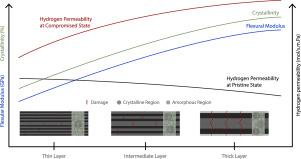Microstructure-driven hydrogen permeability in thin-ply thermoplastic composites: Insights for Type V storage tanks
IF 8.1
2区 材料科学
Q1 ENGINEERING, MANUFACTURING
Composites Part A: Applied Science and Manufacturing
Pub Date : 2025-09-24
DOI:10.1016/j.compositesa.2025.109316
引用次数: 0
Abstract
The potential of thermoplastic composites for gas storage in Type V tanks remains to be fully assessed. Yet, we demonstrate for thin-ply carbon fiber-reinforced polyamide 6 (CF/PA6) composites a strong dependence of the hydrogen permeability to their microstructure. Cross-ply laminates with layer thicknesses of , , and were tested under hydrogen feed pressures of 5, 10, and 15 bar in pristine and pre-damaged states, induced by tensile loading to 60%–80% of ultimate strength. In pristine condition, thin-layer laminates exhibited higher permeability due to lower crystallinity, greater amorphous content, and lower flexural modulus. Thick-layer laminates, with larger crystalline domains, developed more tortuous diffusion paths leading to lower permeability. Increasing pressure decreased permeability through hydrogen-induced crystallization. Thin layers sustained early damage, maintaining consistent damage content at high strains, ensuring allowable permeability, while thick layers resisted initial damage but degraded at high strains, increasing permeability significantly. The findings highlight the impact of microstructure on hydrogen transport and provide key design insights for safe hydrogen storage in Type V tanks using thin-ply CF/PA6 composites.

薄层热塑性复合材料中微结构驱动的氢渗透性:对V型储罐的见解
热塑性复合材料用于V型储罐储气的潜力仍有待充分评估。然而,我们证明了薄层碳纤维增强聚酰胺6 (CF/PA6)复合材料对其微观结构的氢渗透性有很强的依赖性。对层厚分别为42μm、84μm和168μm的交叉层合板在5、10和15 bar的氢气压力下进行了原始和预损伤状态下的拉伸试验,拉伸载荷达到极限强度的60% ~ 80%。在原始状态下,薄层层压板由于结晶度低、非晶含量高和弯曲模量低而表现出更高的渗透性。厚层复合材料的晶域越大,扩散路径越曲折,渗透率越低。压力增加导致氢诱导结晶导致渗透率降低。薄层持续早期损伤,在高应变下损伤含量保持一致,保证允许渗透率;厚层抵抗初始损伤,但在高应变下退化,渗透率显著提高。研究结果强调了微观结构对氢气传输的影响,并为使用薄层CF/PA6复合材料的V型储罐的安全储氢提供了关键的设计见解。
本文章由计算机程序翻译,如有差异,请以英文原文为准。
求助全文
约1分钟内获得全文
求助全文
来源期刊

Composites Part A: Applied Science and Manufacturing
工程技术-材料科学:复合
CiteScore
15.20
自引率
5.70%
发文量
492
审稿时长
30 days
期刊介绍:
Composites Part A: Applied Science and Manufacturing is a comprehensive journal that publishes original research papers, review articles, case studies, short communications, and letters covering various aspects of composite materials science and technology. This includes fibrous and particulate reinforcements in polymeric, metallic, and ceramic matrices, as well as 'natural' composites like wood and biological materials. The journal addresses topics such as properties, design, and manufacture of reinforcing fibers and particles, novel architectures and concepts, multifunctional composites, advancements in fabrication and processing, manufacturing science, process modeling, experimental mechanics, microstructural characterization, interfaces, prediction and measurement of mechanical, physical, and chemical behavior, and performance in service. Additionally, articles on economic and commercial aspects, design, and case studies are welcomed. All submissions undergo rigorous peer review to ensure they contribute significantly and innovatively, maintaining high standards for content and presentation. The editorial team aims to expedite the review process for prompt publication.
 求助内容:
求助内容: 应助结果提醒方式:
应助结果提醒方式:


